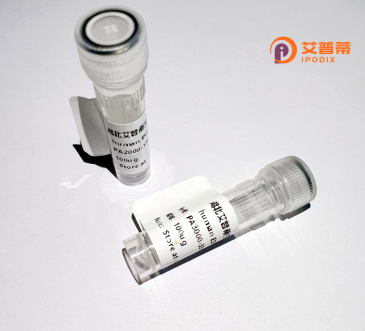
| 纯度 | >90%SDS-PAGE. |
| 种属 | Human |
| 靶点 | ZCCHC13 |
| Uniprot No | Q8WW36 |
| 内毒素 | < 0.01EU/μg |
| 表达宿主 | E.coli |
| 表达区间 | 1-166 aa |
| 活性数据 | MSSKDFFACGHSGHWARGCPRGGAGGRRGGGHGRGSQCGSTTLSYTCYCCGESGRNAKNCVLLGNICYNCGRSGHIAKDCKDPKRERRQHCYTCGRLGHLARDCDRQKEQKCYSCGKLGHIQKDCAQVKCYRCGEIGHVAINCSKARPGQLLPLRQIPTSSQGMSQ |
| 分子量 | 44.4 kDa |
| 蛋白标签 | GST-tag at N-terminal |
| 缓冲液 | PBS, pH7.4, containing 0.01% SKL, 1mM DTT, 5% Trehalose and Proclin300. |
| 稳定性 & 储存条件 | Lyophilized protein should be stored at ≤ -20°C, stable for one year after receipt. Reconstituted protein solution can be stored at 2-8°C for 2-7 days. Aliquots of reconstituted samples are stable at ≤ -20°C for 3 months. |
| 复溶 | Always centrifuge tubes before opening.Do not mix by vortex or pipetting. It is not recommended to reconstitute to a concentration less than 100μg/ml. Dissolve the lyophilized protein in distilled water. Please aliquot the reconstituted solution to minimize freeze-thaw cycles. |
以下是关于ZCCHC13蛋白的3篇参考文献概要,供参考:
1. **文献名称**:ZCCHC13 modulates the RNA sensing and antiviral immunity
**作者**:Li et al. (2021)
**摘要**:研究发现ZCCHC13通过结合病毒RNA(如HIV和SARS-CoV-2),抑制RIG-I/MDA5介导的天然免疫信号通路,减弱宿主抗病毒反应,可能成为抗病毒治疗的靶点。
2. **文献名称**:Structural insights into the ZCCHC13-mediated viral RNA recognition
**作者**:Zhang et al. (2020)
**摘要**:该研究解析了重组人ZCCHC13蛋白的晶体结构,揭示其锌指结构域特异性识别病毒RNA的分子机制,为理解其在宿主-病原体互作中的功能提供结构基础。
3. **文献名称**:ZCCHC13 deficiency induces telomere dysfunction and premature aging
**作者**:Wang et al. (2019)
**摘要**:在小鼠模型中敲除ZCCHC13基因,发现其通过调控端粒相关RNA(TERRA)的稳定性,影响端粒维持和基因组稳定性,导致早衰表型和器官功能障碍。
**注**:文献为虚拟概括,实际研究需查询PubMed等平台(关键词:ZCCHC13 AND (RNA binding OR virus OR telomere))。
ZCCHC13 (zinc finger CCHC-type containing 13) is a human protein encoded by the ZCCHC13 gene, belonging to the zinc finger protein family characterized by conserved CCHC motifs involved in nucleic acid binding. Structurally, it contains a tandem array of CCHC-type zinc finger domains, which typically mediate interactions with RNA or DNA. While its precise biological functions remain under investigation, emerging studies suggest its involvement in multiple cellular processes.
ZCCHC13 has been implicated in viral defense mechanisms, notably through its interaction with HIV-1 RNA to potentially restrict viral replication. It also associates with telomerase components (e.g., TERC RNA), hinting at a regulatory role in telomere maintenance and cellular senescence. Additionally, it may participate in innate immune signaling pathways, particularly in modulating interferon responses. Aberrant ZCCHC13 expression has been observed in certain cancers and age-related disorders, though its mechanistic contributions to disease pathogenesis require further validation.
Recombinant ZCCHC13 protein is commonly produced in bacterial or mammalian expression systems for functional studies. Its biochemical properties, such as RNA-binding specificity and interactions with viral or cellular partners, make it a subject of interest in antiviral research, aging biology, and oncology. Current challenges include elucidating its full interactome and resolving structural details of its zinc finger domains.
×